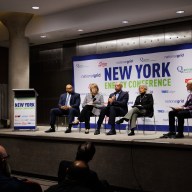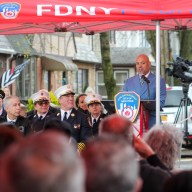By Tom Nicholson
At a conference held at Silvercup Studios in Long Island City, representatives from the Creative Coalition said the plight facing the New York film and television industry, which pumps about $5 billion into the city's economy each year – much of it in Long Island City and in Astoria, where Kaufman Astoria studios are located – will have a negative impact on the economy if something is not done soon.
“We have put together a task force of recognized community, business and entertainment industry leaders with a commitment to New York's economic development issues,” said Tony Goldwyn, of Creative Coalition. “This task force has been put together on behalf of those electricians, set designers and other below-the-line services, dry cleaners, hotel operators, restaurant owners and many others in our communities who have been hit the hardest by runaway production.”
Goldwyn pointed to statistics from the state Department of Labor which showed that media and entertainment jobs in New York have declined by about 10,000 in the last three years. The shifting of jobs away from studios in western Queens and the rest of the city has been termed “runaway production.”
“The runaway production situation has only gotten worse as other countries become more sophisticated in luring American-produced films and television shows,” Goldwyn said.
Stuart Suna, president of Silvercup Studios, said the purpose of meeting with Queens Chamber of Commerce officials was to gain local support for proposed legislation that would give film production companies tax credits to work in New York.
“We lose business to Canada and we lose business to the West Coast,” Suna said. “There is a show that is going to be called “Gramercy Park” that is going to be shot in Los Angeles. We need to have films and shows about New York shot here.”
Suna said the local economy in Long Island City will suffer as more shows go west and north. He said that for every $1 spent on a film or commercial at Silvercup or one of the other studios in the area, the multiplier effect results in $2.20 for the Long Island City and Astoria economy.
“Most of Long Island CIty is support for the film industry here at the studios,” Suna said.
Bill Egan, executive vice president of the Queens Chamber of Commerce, said that while he was aware of the effect a loss of television and film work would have on the local economy, no specific plans to reverse trend have been put in place yet.
“We are going to work with the (Creative Coalition) to see what we can do,” Egan said. “But we haven't sat down with them yet. There will be an impact in Queens from a loss of production at the studios in Astoria, I don't have the exact numbers, but a lot of people depend on production work there.”
Julianne Cho, spokeswoman for the Mayor's Office of Film, Theatre and Broadcasting, said the agency is working on attracting more film and television production work to the city.
“Competition for production work is challenging, particularly at the international level,” Cho said. “We are stepping up our efforts to bring production work here and looking to legislation, in the form of tax credits, to help bring more work here. We have the best talent and the best location in the world and we are stepping up our marketing efforts to stop runaway production.”
Reach Reporter Tom Nicholson by e-mail at news@timesledger.com or by calling 718-229-0300, Ext. 157.





























